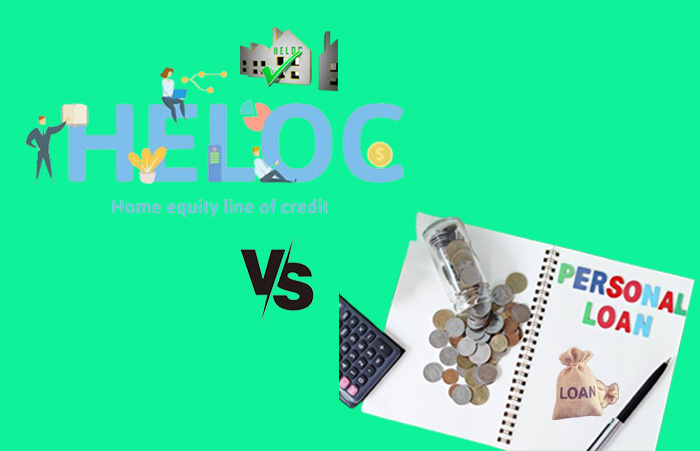HELOC vs. Personal Loan. Have you ever stared at a mountain of credit card debt and dreamt of a financial reset? Or perhaps you’re itching to renovate your kitchen but need more funds upfront. In these situations, two common loan options often come to mind: personal loans and Home Equity Lines of Credit (HELOCs). Personal loans are not backed by collateral, so you don’t need to provide assets like a house or car to secure them. They offer a lump sum of money that you repay in fixed monthly installments over a set term. On the other hand, HELOCs are revolving lines of credit secured by the equity you’ve built up in your home. Think of it like a credit card with a much higher limit but for your home’s value. You can access funds as needed within a draw period and repay them over a separate repayment period.

While both personal loans and HELOCs can help you achieve your financial goals, there are key differences to consider when making a decision. This blog post will delve into these crucial distinctions to empower you to choose the loan that best suits your specific needs.
Understanding HELOCs
Purchasing a home is a major achievement, and as time goes by, it accrues equity, which is the gap between the market value of your home and the remaining balance on your mortgage. This equity can be a valuable financial tool, and a Home Equity Line of Credit (HELOC) is one way to leverage it.
HELOC Explained:
A HELOC is a credit line that uses your home as collateral. Think of it like a credit card with a limit based on your home’s equity. You can borrow against this limit as needed, similar to using a credit card. Unlike a traditional loan with a fixed sum paid out upfront, a HELOC offers flexibility in how you access the funds.
Here’s how it works:
HELOCs function in two distinct phases:
- Draw Period: This initial period typically lasts 10 years and allows you to borrow funds as needed, up to your credit limit. You’ll usually make minimal payments covering only the interest accrued on the borrowed amount.
- Repayment Period: After the draw period ends, the HELOC transitions into a repayment phase. Now, your monthly payments will increase significantly as they will include both the principal and interest. This period can last another 10 to 20 years, depending on the loan terms.
Interest Rates and the Prime Index:
HELOC interest rates usually vary, which means they can change over time. This is because they are often tied to a prime index, most commonly the Prime Rate set by the Federal Reserve. As a credible source, the Federal Reserve Board explains how these rates work on its consumer resources page. An increase in the Prime Rate will directly affect your HELOC’s interest rate, raising your monthly payments during the repayment period.
Understanding Personal Loans
A personal loan is essentially an unsecured (or sometimes secured) loan you borrow from a bank, credit union, or online lender. It provides you with a lump sum of money upfront that you repay in fixed monthly installments over a predetermined period. Unlike credit cards with revolving credit lines, personal loans have a clear structure, making budgeting and repayment more manageable.
How Does it Work?
The appeal of personal loans is in their straightforwardness. Here’s a breakdown of the mechanics:
- Fixed-Sum Loan: You borrow a specific amount of money upfront, agreed upon by you and the lender. This amount is called the principal.
- Set Repayment Term: You and the lender establish a timeframe (usually between 12 and 60 months) within which you’ll repay the loan in full.
- Interest Rate: Since you’re borrowing money, lenders charge interest. This fee is typically expressed as an Annual Percentage Rate (APR), which reflects the total cost of borrowing per year. It’s crucial to compare APRs offered by different lenders to secure the most favorable deal.
Secured vs. Unsecured Personal Loans
Personal loans can be either unsecured or secured. Unsecured loans, as the name suggests, don’t require you to pledge any collateral (like a car or house) to acquire the loan. This makes them easier to obtain, but lenders typically compensate for the higher risk by offering them at slightly higher interest rates.
Conversely, secured personal loans need collateral. By putting up an asset as security, you potentially qualify for a lower interest rate as the lender has a safety net in case of default. However, this also means risking losing your collateral if you fail to make repayments.
The Takeaway:
Personal loans offer a convenient way to access a fixed amount of money for various purposes, from consolidating debt and financing home improvements to covering unexpected expenses. By understanding the core workings of personal loans, including fixed sums, repayment terms, interest rates, and secured vs. unsecured options, you can make informed decisions to leverage this financial tool and achieve your goals.
HELOC vs. Personal Loan: Key Differences
Choosing the right loan can be crucial for any financial project. Two popular options for borrowing money are home equity lines of credit (HELOCs) and personal loans. What are the main differences between these two? Let’s break it down in a clear table to help you decide which is the better fit for your needs:
| Feature | HELOC (Home Equity Line of Credit) | Personal Loan |
| Loan Type | Secured Loan (uses home equity as collateral) | Unsecured Loan (no collateral required) |
| Credit Limit | Revolving credit line with a maximum amount | Fixed loan amount disbursed in a lump sum |
| Interest Rate | Typically variable, based on prime rate + margin | Typically fixed interest rate |
| Closing Costs | This may include appraisal fees, origination fees, and closing costs | This may include origination fees |
| Repayment | Payments of only interest during the draw period, followed by both principal and interest during the repayment period | Fixed monthly payments of principal and interest throughout the loan term |
| Draw Period | Initial period (usually 5-10 years) where you can access the credit line | N/A |
| Repayment Period | Draw period followed by a repayment period (usually 10-20 years) | Fixed repayment term |
| Application Process | Typically, a faster and easier application process | Typically faster and easier application process |
| Tax Deductibility | Interest may be tax-deductible if used for home improvements (consult a tax advisor) | Interest is generally not tax-deductible |
| Suitability | Ongoing or unpredictable expenses, large home improvement projects | One-time expenses, debt consolidation, emergencies |
Additional Considerations:
- Risk: With a HELOC, there is a potential of losing your home should you fail to meet the loan repayment terms. Personal loans do not put your home at risk, but a default can damage your credit score.
- Discipline: HELOCs offer flexibility but require strong financial discipline to avoid overspending. Personal loans provide a scheduled payment arrangement.
Deciding Between a HELOC and a Personal Loan
Between Home Equity Line of Credit (HELOC) and personal loan. But how do you determine the most suitable option? Each has its own set of pros and cons, and the optimal decision hinges on your situation. Let’s analyze the critical factors to weigh in this significant choice.
HELOC (Home Equity Line of Credit):
- Pros:
- Lower Interest Rates: Secured by the equity in your home, HELOCs typically offer lower interest rates than unsecured personal loans. This could result in substantial savings throughout the loan.
- Flexibility: Similar to a credit card, a HELOC operates with a revolving line of credit. You can draw money as needed up to your approved limit, making it ideal for ongoing projects where the final cost might be uncertain.
- Potential Tax Benefits: It may apply to the interest paid on a HELOC when used for home improvements (seek advice from a tax professional for verification).
- Cons:
- Risk to Your Home: Since your home is collateral, failure to repay could lead to foreclosure. This is a significant risk to consider.
- Variable Rates: HELOCs typically have variable interest rates, which means your monthly payment could fluctuate over time. This can make budgeting more challenging.
- Higher Closing Costs: Obtaining a HELOC often involves appraisal and origination fees, making the upfront costs higher than a personal loan.
Personal Loan:
- Pros:
- Fixed Rates and Payments: Personal loans come with fixed interest rates and repayment terms. This provides predictability and simplifies budgeting.
- Faster Approval Process: Getting a personal loan can be a quicker process compared to a HELOC, which requires appraisals and additional paperwork.
- No Risk to Your Home: Personal loans are unsecured, so your home is not at risk if you default on the loan.
- Cons:
- Typically Higher Interest Rates: Because they are unsecured, personal loans generally have higher interest rates than HELOCs.
- Fixed Loan Amount: You receive a lump sum upfront and cannot access additional funds once the loan is used.
- Shorter Repayment Terms: Personal loans typically have shorter repayment terms than HELOCs, resulting in potentially higher monthly payments.
Framework:
Here’s a breakdown to help you decide which loan is best for you:
- Choose a HELOC if:
- You need a large sum of money for a home improvement project or ongoing expenses.
- You have a strong credit score and significant equity in your home to qualify for a low interest rate.
- You are comfortable with the risk of your home being used as collateral.
- Choose a Personal Loan if:
- You need a fixed amount for a one-time expense like debt consolidation or a medical bill.
- You prefer the security of a fixed interest rate and predictable monthly payments.
- You don’t want to put your home at risk or don’t have significant home equity.
Conclusion
HELOC vs. Personal Loan – Remember, financial decisions are personal. Don’t hesitate to consult with a financial advisor who can assess your unique situation and recommend the most suitable loan option for you. They can also help you navigate the application process and ensure you get the best possible terms.

